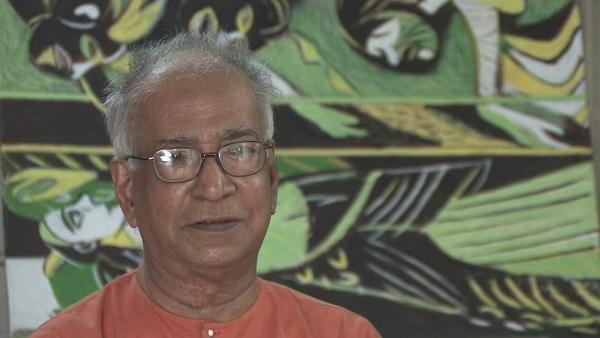NEXT STORY

Art and religion
RELATED STORIES

NEXT STORY

Art and religion
RELATED STORIES


|
Views | Duration | |
|---|---|---|---|
| 11. Travelling to Santiniketan and being searched by the police | 62 | 02:20 | |
| 12. Life at Santiniketan and Nandalal Bose | 122 | 03:36 | |
| 13. Santiniketan and Gandhism | 59 | 05:12 | |
| 14. Mohandas Gandhi and art (Part 1) | 67 | 06:54 | |
| 15. Mohandas Gandhi and art (Part 2) | 60 | 06:52 | |
| 16. Gandhi and Nandalal Bose | 75 | 07:30 | |
| 17. Tagore | 64 | 04:47 | |
| 18. Art and religion | 64 | 06:58 | |
| 19. Benode Behari Mukherjee, Brahma and Tulsidas’ monkey god | 84 | 04:47 | |
| 20. Developing relationships with Benode Bihari Mukherjee and... | 60 | 03:14 |


When you arrived at Santiniketan, Tagore had already been several years dead.
No, not several years, 3 years.
Was there a… did you know about his painting?
I knew about his painting much earlier because really speaking, when I started taking an interest in painting, one of the things I was struck with was what they had published called Chitralippi. It was a sort of publication of Tagore’s. This is the only publication at that time which was published by Visva Bharati. This should be in the 19... early ’30s, and at the same time the first exhibition of Tagore’s works was done by Mukul Dey, I think somewhere in 1932 or so. So it was known. I mean, Tagore’s work was not celebrated by the critics, but then that, Tagore’s work was known, and because 1930 means he started doing this by 1926 or so, after his visit to Argentina and Victoria Ocampo, this sort of thing. He wrote his poem, a sort of group of poems called Purobi and did the illustrations and things of that kind.
Erasures.
Hmm, Erasures. So, it was known. I mean, the whole question was here, and then already even Nandalal had talked about this thing, and I still remember one of Nandalal’s lectures trying to explain Tagore’s paintings in his own way, and it was a lantern lecture in which he had selected various kinds of what you call rhythmic or image analogues of Tagore’s paintings. That is figures which are made like sort of sprouting seeds or showing that sprouting seed, and figures made up by sort of like a splintered glass, this sort of thing. So I remember, I mean people were trying to explain to them or to explain to each other what the special qualities of his work was. It was known, but then of course it didn’t come to the kind of prominence it came to later. Anyway, this was the background of the thing, and especially among the younger people like us, I mean it was only, not only the programme that was, but the freedom you had to choose whatever you wanted to, and also, the impressive Tagore’s literature, his thoughts and other things were there everywhere and in that atmosphere, I really enjoyed my time. It is true that Nandalal later didn’t like certain things I did. I didn’t attend certain classes, but he was quite happy that I was working throughout the night and things of that kind, so I didn’t go early in the morning to their prayers. But then the whole question, he never mentioned anything to me about this. On the other hand, I remember an incident which was quite, yes, I was terribly touched by it. I was in the hostel and I had probably been reading late into the night, in those days by lantern light, and sleeping straight into the morning. The sun was beating on my hair, then I found somebody sort of close the window and then walk away. I said who is this person who has closed the window, and I looked and I found it was Nandalal who had sort of, he was getting me up from bed. He rather thought that I needed that kind of comfort. That thing he had, and he was always very nice, but then it is true, he was not very happy when I asked him that I want to stay one year more, because I spent much less time in Kala Bhavan than the others did because I came late and I stayed about 3 and-a-half years, then I had my sort of degree, then the certificate. I said I wouldn’t mind if you sort of allow me to. He said no, you have got everything you need and the world is your school, and I am happy he sent me away because I would have wasted one more year there instead of going out. But then I am very, very grateful to him, whatever sort of thought openings came through my contact with him and his close associates.
KG Subramanyan (1924-2016) was an Indian artist. A graduate of the renowned art college of Kala Bhavana in Santiniketan, Subramanyan was both a theoretician and an art historian whose writings formed the basis for the study of contemporary Indian art. His own work, which broke down the barrier between artist and artisan, was executed in a wide range of media and drew upon myth and tradition for its inspiration.
Title: Tagore
Listeners: Timothy Hyman
Timothy Hyman is a graduate of Slade School of Fine Art, London, in which he has also taught. In 1980 and 1982, he was Visiting Professor in Baroda, India. Timothy Hyman has curated many significant art exhibitions and has published articles and monographs on both European and Indian artists.
Duration: 4 minutes, 48 seconds
Date story recorded: 2008
Date story went live: 10 September 2010